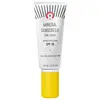What's inside
What's inside
 Key Ingredients
Key Ingredients

 Benefits
Benefits

 Concerns
Concerns

 Ingredients Side-by-side
Ingredients Side-by-side

Homosalate 9%
Skin ConditioningOctocrylene 9%
UV AbsorberEthylhexyl Salicylate 4.5%
UV AbsorberButyl Methoxydibenzoylmethane 2.7%
UV AbsorberWater
Skin ConditioningGlycerin
HumectantDimethicone
EmollientIsododecane
EmollientCetearyl Alcohol
EmollientPotassium Cetyl Phosphate
EmulsifyingAcrylates/Polytrimethylsiloxymethacrylate Copolymer
Skin Conditioning1,2-Hexanediol
Skin ConditioningPanthenol
Skin ConditioningBenzotriazolyl Dodecyl P-Cresol
UV AbsorberGlyceryl Caprylate
EmollientGlyceryl Stearate
EmollientPolymethyl Methacrylate
Magnesium Aluminum Silicate
AbsorbentCetearyl Olivate
Inulin Lauryl Carbamate
Emulsion StabilisingSorbitan Olivate
EmulsifyingCitrus Aurantium Dulcis Peel Oil
MaskingAcrylates/C10-30 Alkyl Acrylate Crosspolymer
Emulsion StabilisingXanthan Gum
EmulsifyingCitrus Aurantifolia Oil
CleansingTromethamine
BufferingSodium Acrylate/Sodium Acryloyldimethyl Taurate Copolymer
Emulsion StabilisingButylene Glycol
HumectantTrisodium EDTA
Pelargonium Graveolens Flower Oil
MaskingRosmarinus Officinalis Leaf Oil
MaskingIsohexadecane
EmollientAvena Sativa Kernel Extract
AbrasiveCalendula Officinalis Flower Extract
MaskingNepeta Cataria Extract
TonicRubus Idaeus Leaf Extract
Skin ConditioningBaptisia Tinctoria Root Extract
Skin ConditioningLonicera Japonica Flower Extract
Skin ConditioningStellaria Media Extract
Skin ConditioningMorinda Citrifolia Fruit Extract
Skin ConditioningLimonene
PerfumingCitronellol
PerfumingGeraniol
PerfumingCitral
PerfumingLinalool
PerfumingHomosalate 9%, Octocrylene 9%, Ethylhexyl Salicylate 4.5%, Butyl Methoxydibenzoylmethane 2.7%, Water, Glycerin, Dimethicone, Isododecane, Cetearyl Alcohol, Potassium Cetyl Phosphate, Acrylates/Polytrimethylsiloxymethacrylate Copolymer, 1,2-Hexanediol, Panthenol, Benzotriazolyl Dodecyl P-Cresol, Glyceryl Caprylate, Glyceryl Stearate, Polymethyl Methacrylate, Magnesium Aluminum Silicate, Cetearyl Olivate, Inulin Lauryl Carbamate, Sorbitan Olivate, Citrus Aurantium Dulcis Peel Oil, Acrylates/C10-30 Alkyl Acrylate Crosspolymer, Xanthan Gum, Citrus Aurantifolia Oil, Tromethamine, Sodium Acrylate/Sodium Acryloyldimethyl Taurate Copolymer, Butylene Glycol, Trisodium EDTA, Pelargonium Graveolens Flower Oil, Rosmarinus Officinalis Leaf Oil, Isohexadecane, Avena Sativa Kernel Extract, Calendula Officinalis Flower Extract, Nepeta Cataria Extract, Rubus Idaeus Leaf Extract, Baptisia Tinctoria Root Extract, Lonicera Japonica Flower Extract, Stellaria Media Extract, Morinda Citrifolia Fruit Extract, Limonene, Citronellol, Geraniol, Citral, Linalool
Zinc Oxide 20%
Cosmetic ColorantWater
Skin ConditioningCaprylic/Capric Triglyceride
MaskingCoconut Alkanes
EmollientGlycerin
HumectantCetearyl Alcohol
EmollientCoco-Glucoside
CleansingAvena Sativa Kernel Meal
AbrasiveTocopherol
AntioxidantPersea Gratissima Oil
Skin ConditioningHelianthus Annuus Seed Oil
EmollientArachidyl Alcohol
EmollientBehenyl Alcohol
EmollientArachidyl Glucoside
EmulsifyingPolyhydroxystearic Acid
EmulsifyingBenzyl Alcohol
PerfumingXanthan Gum
EmulsifyingCoco-Caprylate/Caprate
EmollientZinc Oxide 20%, Water, Caprylic/Capric Triglyceride, Coconut Alkanes, Glycerin, Cetearyl Alcohol, Coco-Glucoside, Avena Sativa Kernel Meal, Tocopherol, Persea Gratissima Oil, Helianthus Annuus Seed Oil, Arachidyl Alcohol, Behenyl Alcohol, Arachidyl Glucoside, Polyhydroxystearic Acid, Benzyl Alcohol, Xanthan Gum, Coco-Caprylate/Caprate
 Reviews
Reviews

Ingredients Explained
These ingredients are found in both products.
Ingredients higher up in an ingredient list are typically present in a larger amount.
Cetearyl alcohol is a mixture of two fatty alcohols: cetyl alcohol and stearyl alcohol. It is mainly used as an emulsifier. Emulsifiers help prevent the separation of oils and products. Due to its composition, it can also be used to thicken a product or help create foam.
Cetearyl alcohol is an emollient. Emollients help soothe and hydrate the skin by trapping moisture.
Studies show Cetearyl alcohol is non-toxic and non-irritating. The FDA allows products labeled "alcohol-free" to have fatty alcohols.
This ingredient is usually derived from plant oils such as palm, vegetable, or coconut oils. There is debate on whether this ingredient will cause acne.
Due to the fatty acid base, this ingredient may not be Malassezia folliculitis safe.
Learn more about Cetearyl AlcoholGlycerin is already naturally found in your skin. It helps moisturize and protect your skin.
A study from 2016 found glycerin to be more effective as a humectant than AHAs and hyaluronic acid.
As a humectant, it helps the skin stay hydrated by pulling moisture to your skin. The low molecular weight of glycerin allows it to pull moisture into the deeper layers of your skin.
Hydrated skin improves your skin barrier; Your skin barrier helps protect against irritants and bacteria.
Glycerin has also been found to have antimicrobial and antiviral properties. Due to these properties, glycerin is often used in wound and burn treatments.
In cosmetics, glycerin is usually derived from plants such as soybean or palm. However, it can also be sourced from animals, such as tallow or animal fat.
This ingredient is organic, colorless, odorless, and non-toxic.
Glycerin is the name for this ingredient in American English. British English uses Glycerol/Glycerine.
Learn more about GlycerinWater. It's the most common cosmetic ingredient of all. You'll usually see it at the top of ingredient lists, meaning that it makes up the largest part of the product.
So why is it so popular? Water most often acts as a solvent - this means that it helps dissolve other ingredients into the formulation.
You'll also recognize water as that liquid we all need to stay alive. If you see this, drink a glass of water. Stay hydrated!
Learn more about WaterXanthan gum is used as a stabilizer and thickener within cosmetic products. It helps give products a sticky, thick feeling - preventing them from being too runny.
On the technical side of things, xanthan gum is a polysaccharide - a combination consisting of multiple sugar molecules bonded together.
Xanthan gum is a pretty common and great ingredient. It is a natural, non-toxic, non-irritating ingredient that is also commonly used in food products.
Learn more about Xanthan Gum